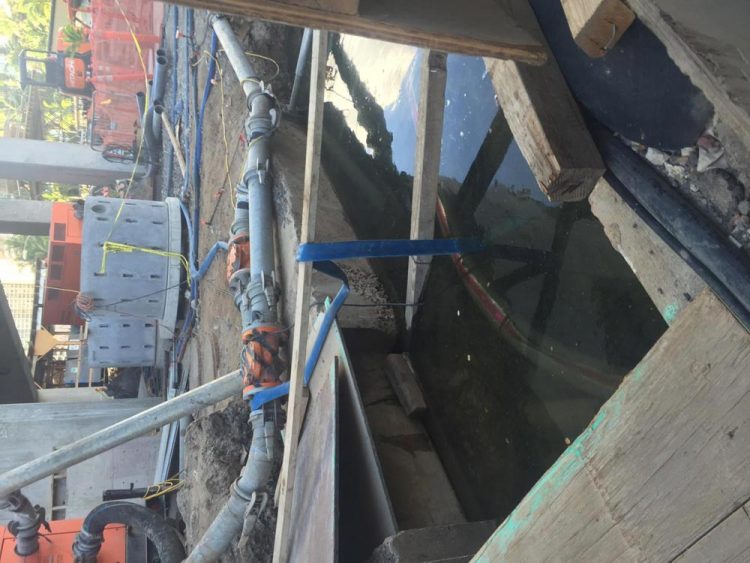As sea level rises, much of Honolulu and Waikiki vulnerable to groundwater inundation

This construction trench in Waikiki shows that the water table is nearly at the ground surface at high tide. Credit: UHM Coastal Geology Group
Shellie Habel, lead author of the study and doctoral student in the UHM Department of Geology and Geophysics, School of Ocean and Earth Science and Technology (SOEST), and colleagues developed a computer model that combines ground elevation, groundwater location, monitoring data, estimates of tidal influence, and numerical groundwater-flow modeling to simulate future flood scenarios in the urban core as sea level rises three feet, as is projected for this century under certain climate change scenarios.
“This flooding will threaten $5 billion of taxable real estate; flood nearly 30 miles of roadway; and impact pedestrians, commercial and recreation activities, tourism, transportation, and infrastructure,” said Habel. “The flooding will occur regardless of seawall construction, and thus will require innovative planning and intensive engineering efforts to accommodate standing water in the streets.”
Surprisingly, the team of researchers also discovered 86% of active cesspools in the study area are likely currently inundated by groundwater. This suggests that cesspool effluent is now entering coastal groundwater and coastal environments in the study area.
Sea level rise of approximately three feet would fully inundate 39 cesspools, introducing effluent at the ground surface where people work and live. This presents a serious health concern that will become progressively more serious as contaminated waters begin breaching the ground surface.
They also found that the water table is close to the ground surface–within two feet at high tide–in many places. This narrow unsaturated space means that groundwater inundation will become a serious concern well before the end of the century. When it rains and infiltration fills this space, it is a problem already.
“Waikiki, the gateway of the state's tourism industry, currently has such narrow unsaturated space that many construction projects working below the ground surface have to dewater the excavation before construction can begin,” said Habel.
“Our findings suggest that coastal communities in Hawai'i and globally are exposed to complex groundwater flooding hazards associated with sea level rise in addition to the typical concerns of coastal erosion and wave overtopping,” said Chip Fletcher, professor of Geology and Geophysics and associate dean in SOEST and principal investigator on the study.
“Groundwater inundation will require entirely unique adaptation methods if we are to continue to live in and develop the coastal zone. Coastal planners and community stakeholders will need to work with architects, engineers, geologists, ecologists, economists, hydrologists, and other innovative thinkers in order to manage these problems.”
This study identified particular locations and infrastructure that will be vulnerable to future flooding and is a crucial first step towards addressing future challenges. The team of researchers hope to use this methodology to identify future flooding and at risk infrastructure in other locations, as well as assist in developing adaptation efforts among vulnerable coastal communities.
###
Habel, S., Fletcher, C.H., Rotzoll, K., El-Kadi, A.I., 2017. Development of a model to simulate groundwater inundation induced by sea-level rise and high tides in Honolulu, Hawaii. Water Research. 114, 122-134. doi: 10.1016/j.watres.2017.02.035
Media Contact
All latest news from the category: Earth Sciences
Earth Sciences (also referred to as Geosciences), which deals with basic issues surrounding our planet, plays a vital role in the area of energy and raw materials supply.
Earth Sciences comprises subjects such as geology, geography, geological informatics, paleontology, mineralogy, petrography, crystallography, geophysics, geodesy, glaciology, cartography, photogrammetry, meteorology and seismology, early-warning systems, earthquake research and polar research.
Newest articles

After 25 years, researchers uncover genetic cause of rare neurological disease
Some families call it a trial of faith. Others just call it a curse. The progressive neurological disease known as spinocerebellar ataxia 4 (SCA4) is a rare condition, but its…

Lower dose of mpox vaccine is safe
… and generates six-week antibody response equivalent to standard regimen. Study highlights need for defined markers of mpox immunity to inform public health use. A dose-sparing intradermal mpox vaccination regimen…

Efficient, sustainable and cost-effective hybrid energy storage system for modern power grids
EU project HyFlow: Over three years of research, the consortium of the EU project HyFlow has successfully developed a highly efficient, sustainable, and cost-effective hybrid energy storage system (HESS) that…





















